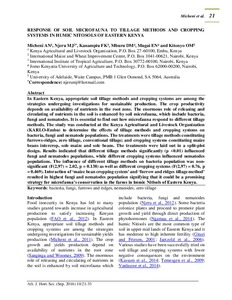| dc.contributor.author | Micheni, A.N. |
| dc.contributor.author | Njeru, M.J. |
| dc.contributor.author | Kanampiu, F.K. |
| dc.contributor.author | Mburu, D.M. |
| dc.contributor.author | Mugai, E.N. |
| dc.contributor.author | Kitonyo, O.M. |
| dc.date.accessioned | 2019-12-04T11:03:49Z |
| dc.date.available | 2019-12-04T11:03:49Z |
| dc.date.issued | 2016-09 |
| dc.identifier.citation | Micheni, A.N., Njeru, M.J., Kanampiu, F.K., Mburu, D.M., Mugai, E.N. & Kitonyo, O.M. (2016). Response of soil microfauna to tillage methods and cropping systems in humic nitosols of Eastern Kenya. African Journal of Horticultural Science, 10. |
| dc.identifier.issn | 1998-9326 |
| dc.identifier.uri | https://hdl.handle.net/20.500.12478/1245 |
| dc.description | Article Purchased |
| dc.description.abstract | In Eastern Kenya, appropriate soil tillage methods and cropping systems are among the strategies undergoing investigations for sustainable production. The crop productivity depends on availability of nutrients in the root zone. The enormous role of releasing and circulating of nutrients in the soil is enhanced by soil microfauna, which include bacteria, fungi and nematodes. It is essential to find out how microfauna respond to different tillage methods. The study was conducted at the Kenya Agricultural and Livestock Organization (KARLO-Embu) to determine the effects of tillage methods and cropping systems on bacteria, fungi and nematode populations. The treatments were tillage methods constituting furrows-ridges, zero tillage, conventional tillage; and cropping systems constituting maize beans intercrop, sole maize and sole beans. The treatments were laid out in a split-plot design. Results indicated that different tillage methods significantly (p <0.01) influenced fungi and nematodes populations, while different cropping systems influenced nematodes populations. The influence of different tillage methods on bacteria population was nonsignificant (F(2,97) = 2.02, p = 0.138) as well as different cropping systems (F(2,97) = 0.76, p = 0.469). Interaction of ‘maize bean cropping system’ and ‘furrow and ridges tillage method’ resulted in highest fungi and nematodes population signifying that it could be a promising strategy for microfauna’s conservation in the farms in humic Nitisols of Eastern Kenya. |
| dc.format.extent | 21-33 |
| dc.language.iso | en |
| dc.subject | Bacteria |
| dc.subject | Fungi |
| dc.subject | Nematodes |
| dc.subject | Zero Tillage |
| dc.title | Response of soil microfauna to tillage methods and cropping systems in humic nitosols of Eastern Kenya |
| dc.type | Journal Article |
| dc.description.version | Peer Review |
| cg.contributor.affiliation | Kenya Agricultural and Livestock Research Organization |
| cg.contributor.affiliation | International Maize and Wheat Improvement Center |
| cg.contributor.affiliation | International Institute of Tropical Agriculture |
| cg.contributor.affiliation | Jomo Kenyatta University of Agriculture and Technology |
| cg.contributor.affiliation | University of Adelaide |
| cg.coverage.region | Africa |
| cg.coverage.region | East Africa |
| cg.coverage.country | Kenya |
| cg.isijournal | ISI Journal |
| cg.authorship.types | CGIAR and developing country institute |
| cg.iitasubject | Crop Systems |
| cg.iitasubject | Food Security |
| cg.iitasubject | Soil Fertility |
| cg.journal | African Journal of Horticultural Science |
| cg.howpublished | Formally Published |
| cg.accessibilitystatus | Open Access |
| local.dspaceid | 78508 |
| cg.targetaudience | Scientists |

